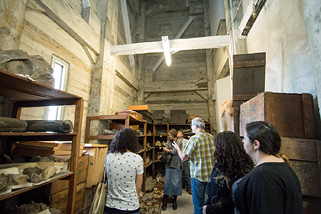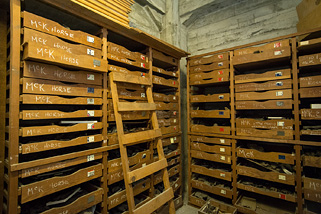

The Campanile will celebrate an important milestone in 2015 — the 100th anniversary of the bell tower (formally know as Sather Tower) — and the UCMP figures prominently in the rich and colorful history of this Bay Area landmark. For many decades, five levels of the tower have been home to fossils collected in the early 1900s, many of which are from Pleistocene tar pit and seep localities in California. These collections contain well-known and charismatic fossils of saber-tooth cats, ground sloths, dire wolves, and camels, among others. These fossils are highlighted in a UC Berkeley Media Relations video featuring Assistant Director for Collections and Research Mark Goodwin, where he dispels the myth that the floors are "just dusty old rooms." A new UCMP grant focused on the Campanile fossils comes with renewed interest in their history.
Funds recently awarded to the UCMP from the Institute of Museum and Library Services (IMLS) will help shine new light on fossils from a lesser known but stratigraphically significant tar seep in the San Joaquin Valley: the Pleistocene-Holocene McKittrick seep from Kern County, CA. Excavations at McKittrick by UCMP scientists in the 1930s yielded thousands of bones of extinct and extant mammals, birds, and reptiles. Due to the importance of these finds, the area was eventually designated a California State Historical Landmark. These fossils span a key climatic transition and extinction event near the Pleistocene-Holocene yet the collection has never been properly curated.
Work is already underway by undergraduates Elyanah Posner, Eric Holt, Melissa Mast, and Michael Tom under the direction of Senior Museum Scientist Pat Holroyd, to curate, rehouse, and capture digital images of the specimens. To date, more than 2500 specimens have been cleaned and cataloged, and more than 500 images of 273 specimens have been added to CalPhotos. Lisa White and the UCMP education and outreach team will develop additional web content and digital learning materials, providing K-12 audiences with activities to better understand the significance of these key fossils.
The UCMP is proud to take part in the year-long Campanile celebration. Please watch our progress online as new images of McKittrick fossils are uploaded on Calphotos, on the UCMP blog, and to the UCMP Twitter (@ucmpberkeley) page. Keep track of the campus-wide celebrations on the Campanile 100th website and enjoy images and historical highlights.
We plan to make the McKittrick collection and other fossils in the Campanile a central focus of the UCMP 2015 CalDay theme and we invite you to join us on Saturday, April 18th.